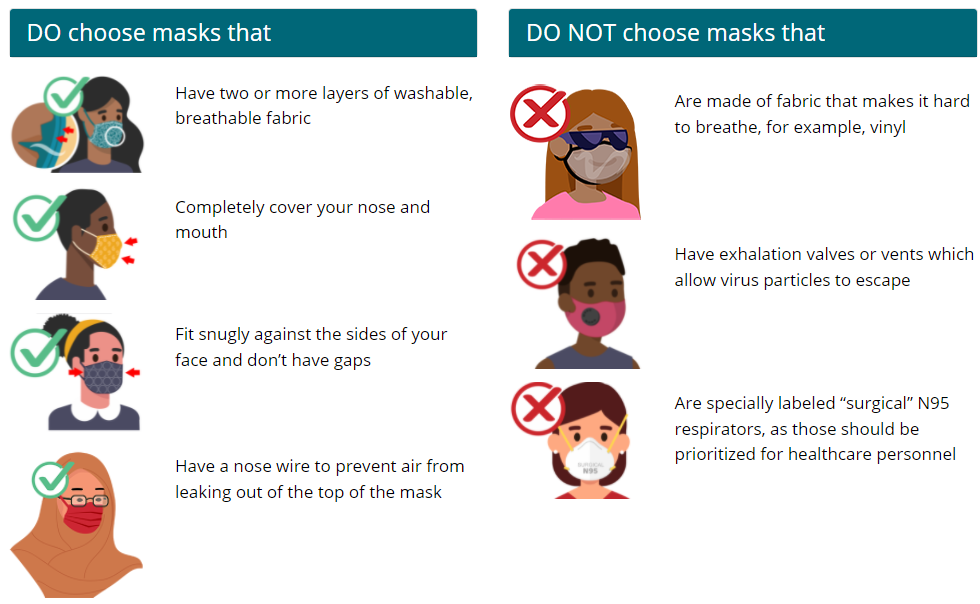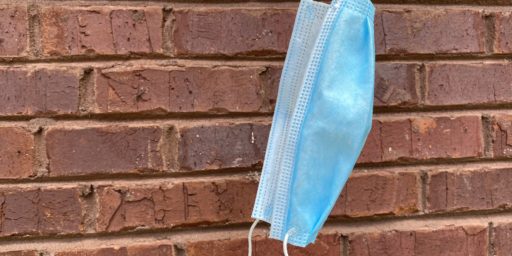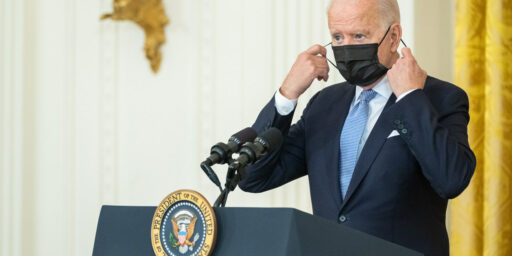Should We All Be in N95 Masks?
Why are we still wearing cloth, which was an emergency measure?

The above graphic is taken from “Your Guide to Masks: How to select, properly wear, clean, and store masks,” published by the Centers for Disease Control and updated on October 25. It applies, for most of us, even if we’re fully vaccinated and boosted in indoor settings.
It remains, for a variety of reasons, controversial. Most Americans, and indeed most people in the developed world, are increasingly living as though the COVID pandemic is over—or are simply over the pandemic and its strictures two years in. And there has long been a controversy over whether it makes sense to mask small children, mask outdoors, and the like.
On the other side are public health experts who argue that the CDC guidelines are actually woefully out of date in the other direction and that Americans should long since have abandoned the cloth masks pictured above and gone to surgical masks—if not upgraded to K/N95s.
As the highly contagious Omicron coronavirus variant continues to spread, some experts say it’s past time to reconsider your face mask options — especially if you’re still wearing the cloth variety.”
Cloth masks are little more than facial decorations. There’s no place for them in light of Omicron,” said CNN Medical Analyst Dr. Leana Wen, an emergency physician and visiting professor of health policy and management at the George Washington University Milken Institute School of Public Health, on CNN Newsroom Tuesday.”This is what scientists and public health officials have been saying for months, many months, in fact,” Wen added in a separate phone interview.
“We need to be wearing at least a three-ply surgical mask,” she said, which is also known as a disposable mask and can be found at most drugstores and some grocery and retail stores. “You can wear a cloth mask on top of that, but do not just wear a cloth mask alone.”
Ideally, in crowded places, “you should be wearing a KN95 or N95 mask,” which can be as inexpensive as a few dollars each, Wen added. By having a better fit and certain materials — such as polypropylene fibers — acting as both mechanical and electrostatic barriers, these masks better prevent tiny particles from getting into your nose or mouth and must be fitted to your face to function properly.
Now, the CDC has rightly earned skepticism on this score, having intentionally misled the public in the early months of the pandemic in order to dissuade panic buying of masks that medical professionals would need. That’s incredibly cynical, as early adoption of mask-wearing would likely have saved a lot of lives, particularly of the elderly and immunocompromised citizens who were most vulnerable.
At the same time, now that most Americans who want to be vaccinated are, it seems rather absurd that we should be wearing masks that cost only a few dollars when going out in public. They’re intended to be worn for a few hours and discarded.
Still, as Wen notes, the cloth masks that most of us wear were an emergency measure.
Other countries, including Germany and Austria, have “switched their standard to say that a face covering in public must be at least a medical-grade surgical mask” in certain settings, she added.
Nor is Wen a lone alarmist in a sea of rational analysts.
Cloth masks — encouraged earlier in the pandemic — can filter large droplets, while more effective masks, such as N95s, can filter both large droplets and the smaller aerosols or particles potentially laden with airborne virus if infected people are present, [Erin Bromage, an associate professor of biology at the University of Massachusetts Dartmouth] said. A cloth face covering also has 75% inward and outward leakage, which the American Conference of Governmental Industrial Hygienists defines as the “percentage of particles entering the facepiece” and the “percentage of particles exhaled by a source exiting the facepiece,” respectively.
Properly fitted N95 respirators that are approved by the US National Institute for Occupational Safety & Health can filter up to 95% of particles in the air, according to the CDC. Surgical or disposable masks are around 5% to 10% less effective than N95 respirators, Bromage said, depending on their ASTM International categorization — with types 1, 2 and 3 ranking just surgical masks from least to most effective.
Why the Omicron variant has been so successful at quickly infecting many people is “unknown at the moment,” but it only underscores the role quality masks can play, Bromage said.”If it is less virus needed, or if it is a person who’s infected is putting more virus out, then the role of a mask in this is if we can cut down the amount that you’re actually breathing in, you get more time,” he added. “If you needed 1,000 viral particles to infect you and you’re wearing something that cuts 50% of things down, it’s now going to take twice as long to get to that 1,000. If you’re wearing one that is a 90% efficient, it’s going to take at least 10 times as long before you get infected when you’re around somebody (who is infected).”
“We need to be promoting better high-quality masks everywhere, because right now a single-layer cloth mask just isn’t cutting it against Omicron,” said former US Surgeon General Dr. Jerome Adams Thursday on CNN’s AC360. “We need more testing. We need better masking. That’s how we get through this.”
In fairness, CDC recommends at least two layers of fabric, not one.
The math is the math. Obviously, a mask that’s 95 percent effective is better than one that’s 25 percent effective, all things being equal. But, if we’re already having a difficult time getting people to mask up, making it radically more uncomfortable, inconvenient, and expensive may not make sense.
Even aside from compliance issues, given the relatively low likelihood of infection on any given trip to the grocery store or other visit to a crowded public space, the slight degradation between surgical masks and N95s would seem the obvious sweet spot. They’re dirt cheap and much easier to obtain than K/N95s. And, of course, we should probably follow the example of just about every other reasonably affluent society and simply make them freely available, such that someone who lost* or forgot their masks can simply grab one on their way into the building.
___________________
*I’m surprised about how much mask litter I see on a routine basis. Pretty much every time I walk from a parking lot into a building, I see at least one mask layin on the ground. And these are almost all cloth masks rather than disposable ones, so I imagine they’re falling out of pockets and such rather than being intentionally discarded in a lazy manner.






The need to have masks that fit well is key, along with wearing one properly. I traveled in November before omicron hit, and the number of people who were wearing masks with their noses exposed was unreal. Either a significant portion of the population is beyond help if they cannot figure out that their noses are part of their respiratory system, or they do not care. At all.
I’ve found a Korean brand of N95 equivalents that come in a variety of sizes-the medium fits me well. They are also quite comfortable.
I’ve been wearing the double-layered disposable surgical masks as long as they’ve been available.
I’ve just upgraded to N95 masks. They are widely available, a bit more expensive to surgical masks. Unfortunately, a lot of masks are being sold as N95s that aren’t. CDC maintains an approved list of manufacturers.
You can also order approved masks through Project N95.
I’ll echo Jen’s comment about masks that fit. They GO OVER YOUR NOSE, and if your glasses fog up, the mask doesn’t fit properly. Wearing a beard also causes leaks.
I’ve upped my mask game because there are so many people wandering around with something on their face that doesn’t do much good.
I think nitpicking this stuff is counterproductive. If somebody wears a mask at all, count your blessings.
@Jen:
I suspect that with some of the ones who wear the masks beneath their noses it’s an issue of believing they can’t breathe properly if their noses are covered. And, like you, I find it annoying.
You can reuse an N95 mask many, many times. Filters actually become more efficient as they are used, I.e an old filter traps more particles than a new one. The reason they go bad is because they gradually require more effort to pass air through.
@Jen:
I wonder about this, too.
I’ve seen several pictures and video of passengers in planes which have undergone decompression, when, as the safety card people ignore states, oxygen masks drop from overhead so people can, you know, not die of hypoxia while the plane descends. Here you see many passengers use the masks over their mouths only.
If you do that and breathe through your nose, you will pass out, incur organ damage, or even die (not likely, but not impossible). And yet these idiots do this.
James, BTW, you can die of a breakthrough infection, regardless of how good your vaccine was against prior variants.
@MarkedMan:
One method I saw a couple days ago is to get four of them, number them 1 through 4, and rotate through them daily in that order. Anything that gets on number 1 will be dead by the time you get back to wearing it three days later.
My family switched to KN95 masks when Omicron hit.
Yeah, the CDC’s obvious b.s. mask guidance early on (and inexplicably continuing to this day) is what convinced me, unequivocally for the first time, that the public health agencies and “experts” really couldn’t be trusted to be honest. Their dedication to the “noble lie”, no matter how transparently nonsensical it is, renders their advice highly suspect at best. Unfortunately, we all have no rational choice but to rely on expert advice when it comes to highly technical matters that we lack the knowledge/training to evaluate effectively beyond looking for basic indicia of credibility like peer review, expert consensus, etc. However, for basic propositions like “wearing a mask helps protect you from airborne respiratory viruses” and “high-filtration medical masks provide more protection than wrapping a freakin’ bandana around your face”, common sense is more than sufficient to reach one’s own conclusions. For that reason, my family and I were in medical N95s from day one (well, except for my stubborn as a mule 80-year old father, who will only wear KN-95s and KF-94s for the sake of comfort) and lowered our guard to ASTM 3 medical masks for casual/brief exposures once we were all vaccinated. Now, with Omicron, we’re back to the N95s. I don’t find the N95s any less comfortable than the cloth masks – and the duck-billed N95s are actually more comfortable in my opinion – so I see no benefit whatsoever to wearing anything less protective.
Incidentally, if anyone’s looking for N95s and ASTM-3s, my go-to storefronts for getting them have been WellBefore and Primo Dental.
We should be yes, but Dr. Joyner is correct, compliance is tough enough as-is, so probably won’t happen.
We should also be calling for a cap on hospitals and ICU beds for the unvaccinated, so we can carefully resume more normalcy. Antivaxxers refuse to listen to the vaccine advice of doctors and nurses, then overwhelm doctors and nurses. It’s unfair and should not stand.
Yes, masking guidance is not very good – a point I’ve made repeatedly here to significant pushback.
Well, one practical problem with a binary mask vs no mask framework is that the places where masks are mandatory have not updated guidance to account for mask quality and fit largely because they are following the CDC recommendations which still are in that binary framework.
I’ve mentioned before here that I’m the legal guardian for my sister who lives in a memory care facility that is a high-risk population. Residents, by and large, can’t wear masks, but there are still no higher-level requirements for visitors and staff except that staff shouldn’t wear cloth masks. Visitors just have to wear a mask – any mask. When I go see my sister, I wear an N95 level mask/respirator because I understand how much better they are compared to lesser alternatives. The staff all wear the ubiquitous procedure masks with various levels of fit. Based on my observation, most staff who wear them have large gaps at the side and around the nose. People who wear glasses understand just how much breath gets deflected through these gaps. And the research over the past 18 months has proven that poor fit greatly reduces mask performance.
And yes, the math is math especially when time is factored in. Viral leakage for a memory care worker on a 12-hour shift in close proximity to people and helping them tasks like eating, bathing, toileting, brushing their teeth, etc. is significantly different if their mask is 30% effective compared to 80%.
We are almost two years into this, there really should be no reason mask requirements in institutional settings of vulnerable populations should not be higher – instead, they are basically the same as the “recommendation” for going to the grocery or any other indoor activity.
And I started to wonder why employers are not simply requiring the use of N95 masks despite what the CDC says. Well, it turns out that N95s are considered respirators and not masks, and since they are respirators, any employer that requires them is subject to OSHA’s “Respiratory Protection Standard” regulations. These standards are scaled to protect employees in highly toxic environments and come with significant compliance costs in terms of mandatory training, tracking, reporting, etc., with potentially significant penalties if the procedures are not followed.
As far as I’m aware, OSHA has not and is not developing an alternative set of rules appropriate for elder care and other settings, or modifying the existing rules that would allow employers to mandate N95s without having to create an entire respiratory compliance program.
For what its worth, I think prioritizing health care workers over even the aged and infirm for masks was a good call, not a bad one.
It’s possible you simply disagree about the lying part, which is unfortunate. Let’s remember who was in charge of the administration at the time.
@Andy:
Any source for this? It sounds like something that would apply to jobs requiring respirators as PPE because of dust or other airborne particulates. I’ve seen N95’s in hospital settings and am not aware of any special tracking required, but I admit it could have been there without my knowing about it.
If you’re going to bother with masks (and everyone should), you should get the best ones you can tolerate.
I find the N95 with back of the head straps the most comfortable — not tugging on ears, and a good enough fit that my glasses don’t fog.
Before that it was surgical masks with a cloth mask over it — but the cloth mask was really just a fashion accessory, a nicer color that matched my jacket.
Dave Barry:
@MarkedMan:
Thank you. This is valuable information. Many of the masks claiming to be N95 are labeled as “single use only disposable” masks. Even an outlay “which can be as inexpensive as a few dollars each” for people who may need to wear a mask every day–and so are thinking that they will need 5 “single use only” masks a week–can be daunting.
And most of the students that I see at the schools I substitute at still wear disposable paper masks provided by the school district. Considering that district wide about 45% of our students qualify for free/reduced price lunches, not many $20-30 mask outlays are forthcoming.
I switched away from N95s to surgical masks after teaching in N95s in Fall 2020. While lecturing, I have to project my voice for hours at a time, and I had a constant sore throat and cough from breathing in my own nasal gunk for hours each day.
I get that it is a lot better to have a closed system. If I had a desk job, I’d likely never have run into this issue. For me, the disposable surgical masks are the best option. But I do need to try to find some that have full handbands rather than ear straps. Those plus glasses kill my poor ear creases.
I’ve been wearing double cloth masks with a PM2.5 filter insert. They are supposed to filter as well as N95’s and the filters are less costly than N95’s
@Gromitt Gunn: take the elastic from an N95, and tie the ear straps of the surgical one to each end.
No more pressure on the ears.
@MarkedMan:
It’s stated in several places but I first found it in the CDC page on mask types:
The relevant part:
Basically, N95 masks are considered “respirators” for regulatory purposes and if an employer were to require N95 masks, then they have to comply with the respirator regulator standards.
But, it also seems like the CDC is on a path to fix this problem by promulgating mask standards for workplaces that don’t dip into the OSHA regulations, which were just released a couple of days ago.
I’m guessing this will allow employers to mandate better masks based on testable standards that, while not at the N95 standard, are still much better than what exists today.
So I think my first comment jumped the gun as I wasn’t aware of that change and I’m very glad to see the CDC was working on that.
@Just nutha ignint cracker: I alternate between a few masks and wear them for months. Recently I got a batch of black ones from Demetech, which is an American company and definitely legit. They won’t show the dirt, so I imagine they will last for many months
@Andy: Here’s the relevant standard. It’s definitely applies and is definitely a mismatch since it presupposes the reason you are wearing a respirator is because of hazards generated in the workplace. It also implies that the respirators in question are of the P100 cartridge variety with an actual plastic mask and so proper fit must be tested and trained.
I strongly recommend that all who do not already have N95 respirators go to https://shop.projectn95.org and buy N95 respirators. They are a non-profit and do not make any money off your purchase. They thoroughly vet all sources. In fact at this point, they get nearly all products directly from the manufacturer. I am not affiliated with the organization. They are the only source I know of that you can truly rely on for getting N95 respirators that are not counterfeit. If I were you, I would not trust any other source offering N95 respirators that are not counterfeit or fraudulent. Keep in mind N95 respirators are single-use items. Do not reuse N95 respirators. Please plan your purchase quantity accordingly.
There is an abundance of non-3M N95 respirators at this point. There is no shortage. Many are extremely affordable such as https://shop.projectn95.org/demetech-n95-respirators-medium-large-bag-of-5/p for $2.60 per N95 respirator.
For students too young to fit a N95 respirator, the best option is https://shop.projectn95.org/children-s-sized-white-kn95-sm-respirator-mask-10-count-bona-fide-masks/p for $1.05/child KN95.